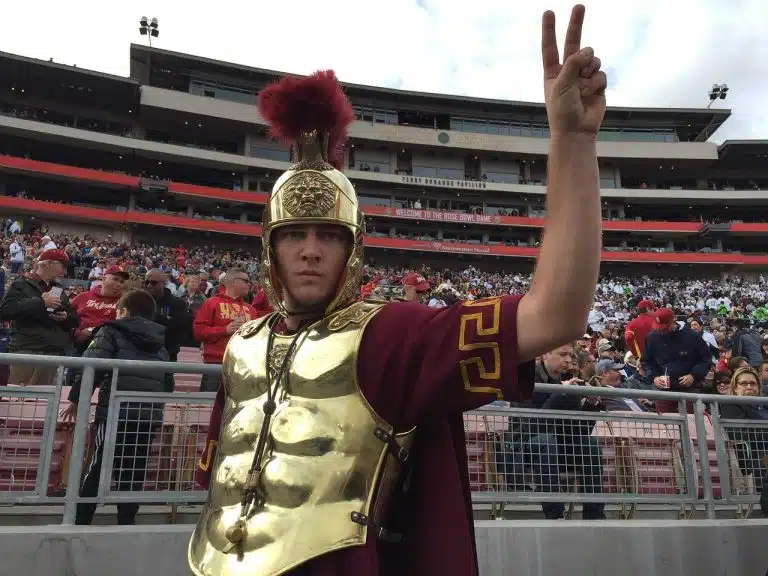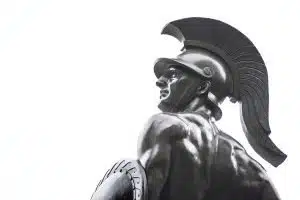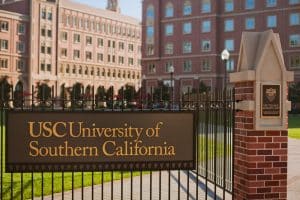The University of Southern California (USC) is known for many things: academic excellence, a stunning campus in Los Angeles, and a vibrant school spirit. Its mascots, Traveler the Horse and Tommy Trojan, have become symbols of USC pride and are well-loved by students and alumni.
But where did they come from? And what do they actually stand for? If you’ve ever wondered what USC’s mascots are all about, keep reading to learn the history and fun facts behind these Trojan icons.
- What Is the USC Mascot?
- Is the USC Mascot Trojan or Traveler?
- Fun Facts About USC’s Mascots
- Frequently Asked Questions
- Takeaways
What Is the USC Mascot?
USC’s mascots are some of the most well-known and spirited mascots in college sports: Traveler and Tommy Trojan. These two mascots are a huge part of what makes USC special, showing up at football games, basketball games, and pretty much every other event to pump up the crowd and represent the school’s rich history and pride.
But before we get into the mascots, what’s a Trojan anyway? Well, the term “Trojan” comes from the ancient city of Troy, which is famous in Classical mythology for its legendary battle against the Greeks in the Trojan War. The Trojans were known for their strength and resilience, and USC adopted that spirit as part of their identity.
Before 1912, USC teams were called the Methodists or Wesleyans, but neither name really stuck. That’s when Warren Bovard, the athletic director (and the son of the university president), asked Owen Bird, a sports editor at the Los Angeles Times, to help come up with a better name.
Bird, who’s the guy credited with coining the term, explained, “The term ‘Trojan’ as applied to USC means that no matter the situation, the odds, or the conditions, the competition must go on, and those who strive must give their all, never growing weary in doing so.”
Is the USC Mascot Trojan or Traveler?
Technically, both. Traveler, the beloved white horse, is USC’s official mascot, while Tommy Trojan is more of a symbolic mascot representing the school’s ideals of strength, courage, and perseverance.
Traveler
Traveler is a noble white horse ridden by a Trojan warrior. He first showed up at a game in 1961, during USC’s home opener against Georgia Tech. The story goes that Bob Jani, who was in charge of special events at USC, and a student named Eddie Tannenbaum spotted a guy named Richard Saukko riding his white horse in the Rose Parade.
They thought it was perfect and asked him to bring the horse, Traveler I, to USC games. And just like that, a tradition was born. Now, every time USC scores, Traveler takes a victory lap around the Coliseum. It’s a moment every Trojan fan looks forward to.
From 1961 to 1988, Traveler was trained and ridden by Saukko. After his passing, his family kept the tradition going until 2003, when Joanne Asman took over as USC’s equestrian manager. Traveler has remained a proud and powerful symbol of the Trojan spirit ever since.
The current Trojan mascot is Traveler IX, a striking white Andalusian gelding. Over the years, the breed has changed, from an Arabian/Tennessee Walker mix to a purebred Arabian and now to a Spanish Andalusian, but one thing has stayed the same: every Traveler has always had the same striking white coat and noble stance.
Tommy Trojan
In addition to Traveler, the university also celebrates the figure of Tommy Trojan, who is often seen as USC’s symbolic mascot. His image is present all over the campus, from the iconic statue to the many costumed versions of Tommy that appear at sporting events, pep rallies, and student functions.
The Tommy Trojan statue, officially called the Trojan Shrine, which stands at the center of campus near the Hahn Plaza, is one of the most photographed landmarks at USC. Unveiled in 1930, the statue was designed by sculptor Roger Noble Burnham based on many USC football team players. It portrays a heroic Trojan warrior holding a sword, ready to defend his people.
The statue is so beloved by the Trojan community that it has become a famous campus meeting spot, where you’ll often see students gather and snap photos. They also decorate or protect the statue during “Conquest Week” before the annual football game against their fierce rival, the University of California, Los Angeles (UCLA).
Fun Facts About USC’s Mascots
College mascots represent school pride, tradition, and spirit. Whether it’s leading the crowd at a game or making special appearances around campus, USC’s mascots have become symbols of what it means to be a Trojan. Here are some fun facts you might not know about them:
1. Traveler’s rider isn’t always male.
While Traveler is usually ridden by someone dressed as a Trojan warrior, the person behind the costume isn’t always a man. In fact, Travelers’ first female rider, Dana Kanstul, made history by taking on the role. More than gender, what’s important is the rider’s ability to handle the horse with confidence and poise in a loud, high-energy environment.
2. Tommy Trojan was created to cash in on merchandise.
Yup, you read that right. The creation of the mascot came from a desire to boost school spirit and develop merchandise that would appeal to younger audiences, according to Sam Carter, former Creative Director of Auxiliary Services.
He explained that school spirit was “being held hostage” because USC’s only mascot, Traveler, appeared exclusively at football games. Tommy Trojan made his debut in 2013, with Neal Pecchenino, a senior majoring in business administration at the time, being the first to wear the iconic armor.
3. There’s a USC fight song dedicated to the mascots.
Every time Traveler gallops onto the field, USC’s marching band plays “Conquest,” the university’s iconic fight song. This song has become tightly connected to Traveler’s entrance, helping fire up the crowd and bring that signature Trojan energy to every game.
Interestingly, the music behind “Conquest” comes from Alfred Newman’s regal processional march, originally written for the 1947 movie Captain from Castile. It was adopted by USC in 1954 during a basketball game against Oregon State University (OSU), and it’s now played after every USC score and victory.
4. There’s a fund to keep Traveler galloping strong.
The Traveler Fund through USC Recreational Sports helps make sure USC’s beloved mascot continues to play a big role at football games and other events. Whether it’s a small donation of $5 or a larger contribution of $500, every bit helps keep this iconic Trojan tradition alive for future generations.
5. Traveler has a dedicated trainer.
Equestrian manager Joanne Asman has been responsible for providing, training, and housing Traveler since 2003. She took over the reins from Patricia Saukko DeBernardi, the widow of the original Traveler rider and owner Richard Saukko, who retired from the mascot program after the 2002 football season.
Asman is also the owner of Asman & Associates, a highly regarded entertainment and event planning company based in Burbank, California. Through her company, she has produced numerous charity equestrian events, including the Fiesta of the Spanish Horse, the Festival of the Animals, and the Burbank Celebrity Tournament of Horses equestrian show, among others.
5. The role of the Tommy Trojan is open to students.
Did you know that you can volunteer to become Tommy Trojan? If you’re passionate about USC and want to suit up in costume, you can audition for the position. Obviously, it requires physical strength and endurance, plus the confidence and ability to handle the pressure of representing the Trojan community.
Amy Vandenberg, a student who’s been rallying basketball fans in costume, explains that being Tommy is a unique experience where you can “take on an alternate persona, be your crazy self, or just be whoever your character is, and no one knows it’s you.”
6. Tommy Trojan’s suit weighs more than you think.
Speaking of physical strength, suiting up as Tommy Trojan is no walk in the park. It takes about 15 minutes to get into the costume, with a little help.
First, a muscle-bound spandex under-suit is worn, followed by Tommy’s “skin.” Then come the bulky pants with built-in muscles, a barrel-shaped “super chest,” the massive head, helmet, and sandaled feet. The entire costume weighs around 20 pounds, not counting the heavy sword and helmet.
It’s sweaty work, even with a battery-powered fan inside the head. Thankfully, the under-suit gets dry-cleaned regularly!
7. Traveler has been caught up in controversy.
USC’s famous mascot has actually been caught up in some previous drama. A student group once accused that the horse’s name, Traveler, was a symbol of racism because it sounded like the name of a horse owned by Confederate General Robert E. Lee.
Now, USC’s Traveler has one “L” in its name, while Lee’s horse was spelled with two “L’s.” The controversy came up during a rally on campus, where a leader of the group brought up the name issue while protesting the violence in Charlottesville, Virginia.
The original rider of Traveler, Richard Saukko, passed away in 1992 without ever clearing up whether the name was meant to reference Lee’s horse. But his wife, Patricia Saukko, denied the claims, saying it was just a political issue. She also pointed out that when Richard bought the horse in 1958, the horse’s name had already been decided.
8. USC once had a canine mascot.
Before horses, USC’s mascot was a scrappy mutt named George Tirebiter. George first appeared at football games in 1940 and quickly became a campus legend, known for his habit of chasing cars around the USC campus.
Sadly, George didn’t live forever. After surviving a famous dognapping by UCLA in 1947 (where the Bruins shaved “UCLA” into his fur!), he tragically passed away in 1950 when he was hit by a car. A funeral was held to honor the beloved mascot. He was followed by George II for three years, George III for five years, and George IV for four years before Traveler took over in 1961.
Frequently Asked Questions
1. What is the mascot for USC Trojans?
It’s actually both Traveler and Tommy Trojan! Traveler is the official mascot and refers to the majestic horse that leads the USC marching band onto the field. Meanwhile, Tommy Trojan is the warrior figure who symbolizes the school’s athletic pride. Traveler is a live horse, while Tommy Trojan is typically portrayed by a person in costume or by the iconic statue on campus.
2. Is the USC mascot female?
They can be! The rider of Traveler the horse can be female, with Dana Kanstul being the first female rider in 2017. Additionally, female students can also wear the Tommy Trojan costume. Both mascot roles are open to anyone who wants to represent USC.
3. Who is USC’s biggest rival?
USC’s biggest rival is UCLA. The two schools compete fiercely in nearly every sport, but their rivalry is most intense during their football games, often referred to as the “Battle for Los Angeles.” The rivalry is deeply ingrained in both schools’ histories and is one of the most celebrated in collegiate sports.
Takeaways
- USC’s official mascot is Traveler, a majestic white horse that has been part of the Trojan tradition since 1961.
- Tommy Trojan is more of a symbolic mascot, represented by an individual wearing the costume at events and by a statue that stands proudly on campus.
- USC’s biggest sports rivalry is with UCLA, which has been going on for decades.
- Hire a private admissions consultant to assist with your USC application and guide you toward becoming a full-fledged Trojan.




